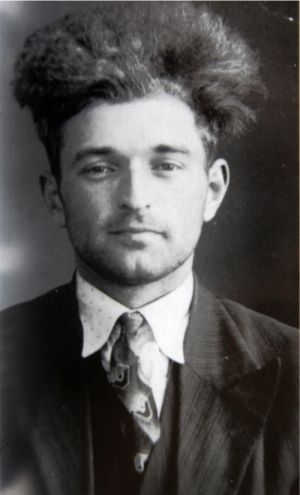Introduction
Once the Germans had occupied the Netherlands in 1940, the persecution of the Jewish part of the population began. After two months the first of an endless series of measures was released. The measures were intended to, incrementally, isolate the Jewish population and ultimately remove them from society (see anti-Jewish measures in the Netherlands for an overview).
The so-called Column Henneicke was employed during the final period of the persecution of the Jewish population in the Netherlands. The group, led by Willem Henneicke and Willem Briedé, was active in the period from March to September 1943. It was a party of about fifty Dutch bounty hunters, who tracked down Jews in hiding and extradited them to the German authorities. They would also trace down Jewish property which they would take for their own benefit.
Definitielijst
- Jews
- Middle Eastern people with own religion that lived in Palestine. They distinguished themselves by their strong monotheism and the strict observance of the Law and tradition. During World War 2 the Jewish people were ruthlessly persecuted and annihilated by the German Nazis. . An estimated 6,000,000 Jews were exterminated.
Images
History
In the German organizational structure, Reichskommissar Arthur Seyss-Inquart, was the highest authority in the occupied Netherlands. Directly reporting to him was Hanns Rauter, the Generalkommissar für das Sicherheitswesen and besides that he was Höhere SS-und Polizieführer, which made him the highest chief of police of the occupying power. Reporting to Rauter was Dr. Wilhelm Harster, the Befehlshaber der Sicherheitspolizei und des SD (= security service), who was also commander of camp Amersfoort.
Under Harster’s command Department IVB4 was set up. The name of this department was copied exactly from the department of Adolf Eichmann in his Berlin headquarters. Willi Zopf was the highest national governor of that department with Willi Lages holding responsibility for the Zentralstelle für jüdische Auswanderung (=central department for Jewish emigration), the institution which was responsible for the deportation of Dutch Jews. Lages delegated the daily management of the Zentralstelle to Ferdinand Aus der Funten and Karl Wörlein.
From 1942, the Nazi extermination machine started running at full speed. Primarily a German concern, but supported by Dutch collaborators. Of the estimated 160,000 registered Jews, weekly, thousands were transported to death camps in Poland. Later on it was established that more than 100,000 Dutch Jews did not survive the war.
Mid March 1943, the Germans ascertained that about 25,000 Jews had been able to flee or go in hiding. Two decisions were then taken by Harster, Lages and Zopf. In the first instance, they directed that every police force in a large or medium-sized town should have a special service within the corps that would be engaged to hunt Jews together with the Gestapo and the SD (Sicherheitsdienst/security service). These special forces were primarily staffed with NSB members, who, from then on, would be searching intensively for Jews in hiding. In all major cities, special departments was installed, with names such as:
- Politieke Dienst (Political Service) Amersfoort, Breda, Delft, Dordrecht, Enschede, Gouda, Helmond, Nijmegen and Zwolle;
- Documentatie Dienst (Documentation Department) The Hague, Leiden,
- Inlichtingendienst (Intelligence Service) Haarlem and Velsen,
- Preventieve Politie (Preventive Police) Eindhoven,
- Politieke Recherche (Political Investigation) Tilburg,
- Bijzondere Recherche (Special Investigation) Groningen and Utrecht,
- Group 10 Rotterdam
and for those who would like to operate in a less shrouded way:
- the Bureau Joodsche Zaken (Bureau Jewish Affairs) Amsterdam and
- The Joden Ploeg (the Jews Work Party) Amersfoort.
All these special services were manned with about 300 men in total.
Secondly, in order to stimulate the tracing down approximately 25,000 Jews in hiding, Harster, Lages and Zopf decided to implement a premium system. Harster set the premium at seven guilders and fifty cents per person, an amount that could be doubled if the Jewish arrestee had violated regulations. These premiums could be paid to police officers from the Bureau of Jewish Affairs of the Amsterdam Police and to civilian officials who worked in subdivisions of the Zentralstelle. Moreover, a large budget would be made available for informants. The Column Henneicke, consisting of fifty men, was one of such subdivisions.
Definitielijst
- Jews
- Middle Eastern people with own religion that lived in Palestine. They distinguished themselves by their strong monotheism and the strict observance of the Law and tradition. During World War 2 the Jewish people were ruthlessly persecuted and annihilated by the German Nazis. . An estimated 6,000,000 Jews were exterminated.
- Mid
- Military intelligence service.
- Nazi
- Abbreviation of a national socialist.
- NSB
- National Socialist Movement. Dutch political party sympathising with the Nazis.
- Reichskommissar
- Title of amongst others Arthur Seyss-Inquart, the highest representative of the German authority during the occupation of The Netherlands.
Images
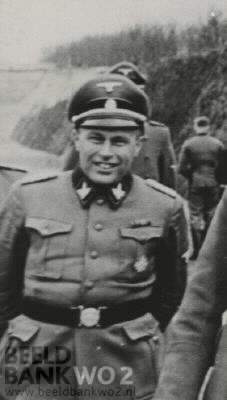 Dr. Wilhelm Harster, commander of the Sipo and SD in the Netherlands. Source: Beeldbank WO2.
Dr. Wilhelm Harster, commander of the Sipo and SD in the Netherlands. Source: Beeldbank WO2.Robbery
The occupier assigned a central role to the bank Lippmann-Rosenthal & Co. in Amsterdam on Sarphatistraat in the looting of Jewish homes. On August 8th, 1941 and May 21st, 1942, two so called LiRo regulations were proclaimed that ordered Jewish people to state all their goods and possessions and to relinquish them. However, what was to be done with all the furniture of the vacated homes of deported Jews? In 1942, the Hausraterfassungsstelle (furniture collecting point) was established with, as a first assignment, making a furniture inventory of all Jewish homes in order to know exactly what the infamous removal company, A. Pulse, took away in its trucks as they left from Jewish homes. Pulse was a removal company which gained notoriety so quickly that the word "pulse" was introduced in the Dutch language as a synonym for robbery. All property was clearly registered: every table, every lamp, every tea cup, each letter opener. For making inventories, the Hausraterfassungsstelle had a number of stock takers at its disposal, who drafted the lists and sent out copies to the Zentralstelle (central office), to the Lippmann-Rosenthal bank and to the Einsatzstab Rosenberg (an organization which was responsible for the transportation of stolen goods to Germany for the refurbishment of bombed homes and offices).
The Hausraterfassungsstelle, led by William Briedé, was originally an administrative office that was formed to ensure a good performance of the operation, which was carried out by the Dutch officials with German precision and discipline. In the central card file, all Jewish possessions were registered with a Hausraterfassungssnummer (HR number, goods collection number), so one knew exactly what and where the possessions of every Jew were. The Hausraterfassungsstelle had separate departments and, subsequently, separate warehouses for carpets, paintings, antiques, furniture, gold, silver, jewellery and ramsj (Jewish for lumber). The Hausraterfassungsstelle had four subdivisions, called columns which were called after their chiefs. Initially, it was Column Ragut, Column Stork, Column Docter and Column Harmans.
The Column Harmans was the detective department, responsible for the detection of stolen or embezzled Jewish goods. Many Jews had entrusted their valuables with friends, colleagues, neighbours or even strangers in an effort to bypass the Second LiRo regulation. For many of those who returned after the war and demanded their rightful ownership, it turned out to be a very painful and disappointing discovery. Unfortunately, the detective work was not done by experienced police officers. Nearly all the staff came from the files of the Regional Employment Board. The only condition was that one had to be a member of the NSB (National Socialist Movement). Although the organization was structured in a strict and tight manner, there was plenty of abuse of certain positions. Before the firm Pulse could do her work, quite a few things seemed to have disappeared already. This caused Willi Lages to sack Harmans quickly and to replace him with Willem Henneicke, a 33-year-old former car mechanic with shady contacts in the underworld.
Definitielijst
- Jews
- Middle Eastern people with own religion that lived in Palestine. They distinguished themselves by their strong monotheism and the strict observance of the Law and tradition. During World War 2 the Jewish people were ruthlessly persecuted and annihilated by the German Nazis. . An estimated 6,000,000 Jews were exterminated.
- NSB
- National Socialist Movement. Dutch political party sympathising with the Nazis.
Images
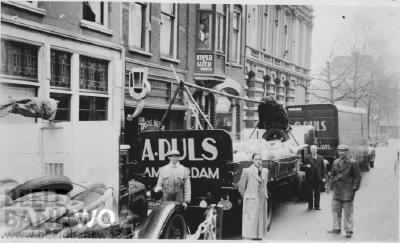 The Household effects of the houses that were left by the Jews, were as a rule removed by the Puls removal firm. Source: Beeldbank WO2.
The Household effects of the houses that were left by the Jews, were as a rule removed by the Puls removal firm. Source: Beeldbank WO2.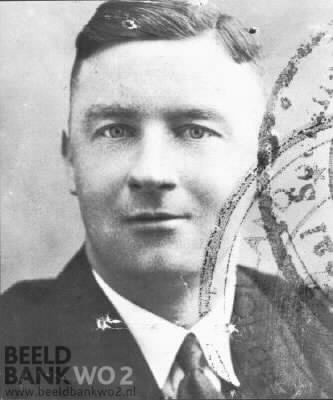 NSB member Abraham Puls, the owner of the removal firm. Source: Beeldbank WO2.
NSB member Abraham Puls, the owner of the removal firm. Source: Beeldbank WO2.Bounty hunters
From that moment on, the department was called the Column Henneicke. Until September 1943, this column would conduct a reign of terror. Already, Henneicke and his comrades began to expand their activities. The administration and inventory faded into the background. Bearing the premiums in mind, they went on an intensive seach for Jews in hiding during which they did not hesitate to take Jewish property. Very soon all Column members lived in certain prosperity, while in preceding years they were receiving unemployment benefits.
By using informants, violence and blackmail, the Germans and collaborators had been able to arrest about 8,500 Jewish people in hiding and to deliver them at the Hollandsche Schouwburg*. Only a few survived the war. Therefore, one can easily say that the Column can be held responsible for several thousands of murders, in total; around fifty men, who were out there for half a year are responsible for a few dozen to several hundred deaths. After September 1944, when the last trains went from Amsterdam to Westerbork, the majority of employees continued with similar activities. In December 1944, Willem Henneicke was killed by the resistance; Briedé fled to Germany in time and managed to escape punishment.
Still there were more who had a narrow escape, but the majority had been taken to court in the period 1947-1949. Many death verdicts were passed, but, later on, almost all were converted to life imprisonment, which ultimately meant twenty years of imprisonment. Between 1959 and 1960, the majority of the convicts were released from prison.
* this was originally a very popular theatre in Amsterdam, which, in 1941, had been renamed by the Germans to Jewish Theatre’. In 1942 the building was destined as collection point for Jews to be deported to transit camp Westerbork. Jews from Amsterdam and neighbouring places could report themselves here voluntarily for deportation or were taken here by force by the Germans, pending deportation.
Definitielijst
- Jews
- Middle Eastern people with own religion that lived in Palestine. They distinguished themselves by their strong monotheism and the strict observance of the Law and tradition. During World War 2 the Jewish people were ruthlessly persecuted and annihilated by the German Nazis. . An estimated 6,000,000 Jews were exterminated.
- resistance
- Resistance against the enemy. Often also with armed resources.
Images
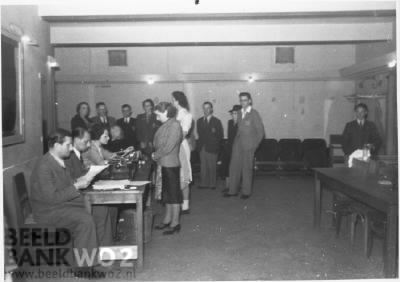 Registration of the arrested Jews in the Hollandsche Schouwburg on the Plantage Middenlaan. Source: Beeldbank WO2.
Registration of the arrested Jews in the Hollandsche Schouwburg on the Plantage Middenlaan. Source: Beeldbank WO2.Information
- Article by:
- Frans van den Muijsenberg
- Translated by:
- Chrit Houben
- Published on:
- 31-07-2012
- Last edit on:
- 14-06-2020
- Feedback?
- Send it!
